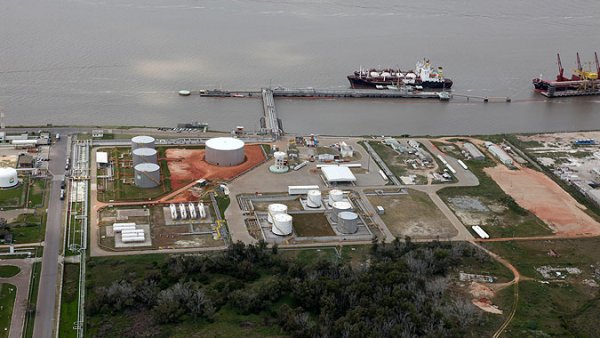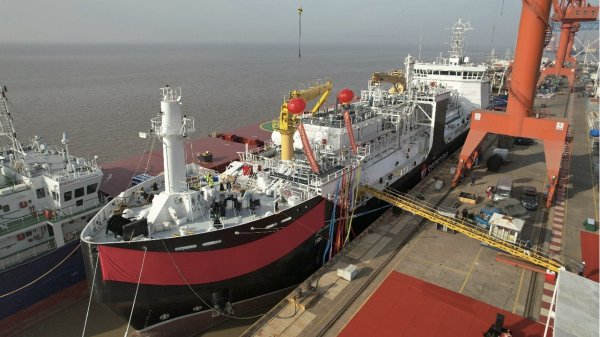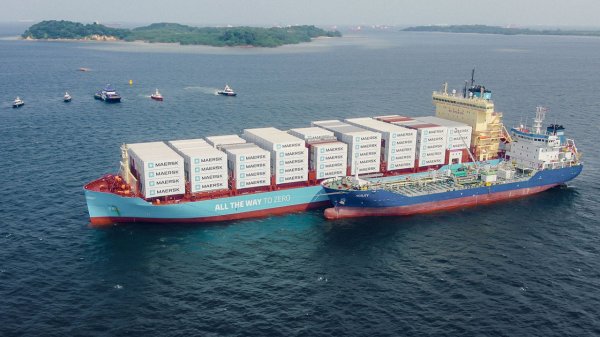Bunker-saving windshield for boxships yields 2% CO2 reduction: MOL
Windshield was installed on the bow of a containership, which sailed at 17 knots per hour.
Mitsui O.S.K. Lines, Ltd. (MOL) says it has completed an in-service demonstration test of a bunker-saving, wind resistance-reducing windshield for containerships, and determined that the device reduces emissions of carbon dioxide (CO2) by an average of 2 percent.
In the test, the windshield was installed on the bow of a containership, which sailed at 17 knots per hour. The results were then compared to an identical vessel operating at the same speed without the device installed.
One objective of the test was to accumulate so-called 'big data' on the operational status of the vessel during service on the Asia-North America East Coast routes, and compare the two sister ships with and without the windshield installed on the bow.
The other aim of the project was to establish a method to eliminate the data on the effects of ocean waves, and extract only the change in performance due to reduced wind resistance.
The analysis method and results of the performance were presented at the Japan Society of Naval Architects and Ocean Engineers' autumn and spring meetings, held in November 2016 and May 2017 respectively.
"MOL continues efforts to confirm the windshield's seaworthiness and sailing data analysis, and looks forward to more advanced technological development based on this research project," the Japanese shipowner said.
MOL originally announced that it had commenced demonstration tests of a new bunker-saving windshield for boxships back in September 2015. The windshield was installed on the bow of the MOL-operated containership MOL Marvel.
Explaining the reason for developing the windshield at the time, MOL said: "With today's larger containerships, the height of the containers loaded on their decks has increased, subjecting the vessels to greater wind resistance. MOL recognized the need to address this issue in a cost-effective way.
"Development of the new device began with an examination of the bow's aerodynamic form through wind tunnel testing. This led to the adoption of a horseshoe-shaped design, which encloses the front line of the stacked containers to maximize the wind resistance-reducing effect while minimizing the weight of the main unit.
"The new windshield has enough design strength to meet the ClassNK rules concerning wave impact pressure. In addition, by obliquely setting the containers placed along the sides of the vessel behind the windshield, the sides of the vessel will be more streamlined, further reducing wind resistance."
Image: Windshield installed on the bow of a MOL-operated containership.
In the test, the windshield was installed on the bow of a containership, which sailed at 17 knots per hour. The results were then compared to an identical vessel operating at the same speed without the device installed.
One objective of the test was to accumulate so-called 'big data' on the operational status of the vessel during service on the Asia-North America East Coast routes, and compare the two sister ships with and without the windshield installed on the bow.
The other aim of the project was to establish a method to eliminate the data on the effects of ocean waves, and extract only the change in performance due to reduced wind resistance.
The analysis method and results of the performance were presented at the Japan Society of Naval Architects and Ocean Engineers' autumn and spring meetings, held in November 2016 and May 2017 respectively.
"MOL continues efforts to confirm the windshield's seaworthiness and sailing data analysis, and looks forward to more advanced technological development based on this research project," the Japanese shipowner said.
MOL originally announced that it had commenced demonstration tests of a new bunker-saving windshield for boxships back in September 2015. The windshield was installed on the bow of the MOL-operated containership MOL Marvel.
Explaining the reason for developing the windshield at the time, MOL said: "With today's larger containerships, the height of the containers loaded on their decks has increased, subjecting the vessels to greater wind resistance. MOL recognized the need to address this issue in a cost-effective way.
"Development of the new device began with an examination of the bow's aerodynamic form through wind tunnel testing. This led to the adoption of a horseshoe-shaped design, which encloses the front line of the stacked containers to maximize the wind resistance-reducing effect while minimizing the weight of the main unit.
"The new windshield has enough design strength to meet the ClassNK rules concerning wave impact pressure. In addition, by obliquely setting the containers placed along the sides of the vessel behind the windshield, the sides of the vessel will be more streamlined, further reducing wind resistance."
Image: Windshield installed on the bow of a MOL-operated containership.

|
VARO Energy expands renewable portfolio with Preem acquisition
All-cash transaction expected to complete in the latter half of 2025. |
|
|
|
||

|
NYK trials biofuel in milestone coal carrier test
Vessel is used to test biofuel for domestic utility company. |
|
|
|
||

|
H-Line Shipping orders LNG bunkering vessel
Vessel with 18,000-cbm capacity to run on both LNG and MDO. |
|
|
|
||

|
How to engineer and manage green shipping fuels | Stanley George, VPS
Effective management strategies and insights for evolving fuel use. |
|
|
|
||

|
Swedish government bans scrubber wastewater discharges
Discharges from open-loop scrubbers to be prohibited in Swedish waters from July 2025. |
|
|
|
||

|
MAN Energy Solutions achieves 100% load milestone for ammonia engine
Latest tests validate fuel injection system throughout the entire load curve. |
|
|
|
||

|
Petrobras secures ISCC EU RED certification for B24 biofuel blend at Rio Grande
Blend consisting of 24% FAME is said to have been rigorously tested to meet international standards. |
|
|
|
||

|
Stolt-Nielsen to fully control Avenir LNG with acquisition
Share purchase agreement to buy all shares from Golar LNG and Aequitas. |
|
|
|
||

|
Bureau Veritas supports launch of CIMC SOE's LNG bunkering vessel
Handover of Seaspan Energy's cutting-edge 7,600-cbm vessel completed. |
|
|
|
||

|
Methanol as a marine fuel | Steve Bee, VPS
How environmental legislation has driven the development of low-sulphur fuels and methanol-ready ships. |
|
|
|
||
Related Links
- · Osaka Gas to supply Japan's first LNG-fuelled tug in 2019 [Insights]
- · Methanol-powered ship delivered in Japan [Insights]
- · 'Next-gen' car carrier to feature fuel-saving rounded bow [Insights]
- · MOL wins eco awards in California [Insights]
- · Japan [Directory]

